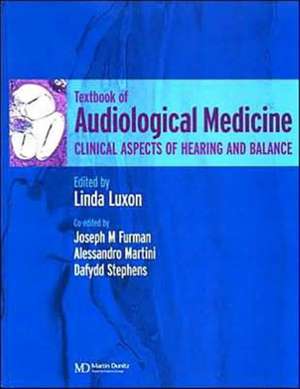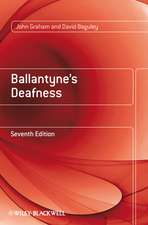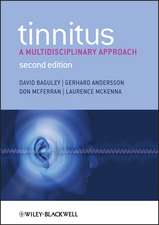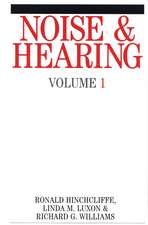A Textbook of Audiological Medicine: Clinical Aspects of Hearing and Balance
Editat de Linda Luxon, Joseph M. Furman, Alessandro Martini, S. Dafydd G. Stephensen Limba Engleză Hardback – 19 dec 2002
Preț: 1284.05 lei
Preț vechi: 1538.54 lei
-17% Nou
Puncte Express: 1926
Preț estimativ în valută:
245.73€ • 255.09$ • 204.90£
245.73€ • 255.09$ • 204.90£
Carte tipărită la comandă
Livrare economică 24 martie-07 aprilie
Preluare comenzi: 021 569.72.76
Specificații
ISBN-13: 9781901865349
ISBN-10: 1901865347
Pagini: 974
Ilustrații: 725 b/w images, 50 color images and 565 line drawings
Dimensiuni: 216 x 280 x 45 mm
Greutate: 2.47 kg
Ediția:1
Editura: CRC Press
Colecția CRC Press
Locul publicării:Boca Raton, United States
ISBN-10: 1901865347
Pagini: 974
Ilustrații: 725 b/w images, 50 color images and 565 line drawings
Dimensiuni: 216 x 280 x 45 mm
Greutate: 2.47 kg
Ediția:1
Editura: CRC Press
Colecția CRC Press
Locul publicării:Boca Raton, United States
Public țintă
Professional, Professional Practice & Development, and Professional ReferenceCuprins
Section I: Fundamentals of audiological and vestibular medicine. Anatomy of peripheral auditory and vestibular systems. Aging in the auditory and vestibular systems. Pathology of the ear. Genetics of auditory and vestibular disorders. Immunology of cochlear and vestibular disorders. The epidemiology of hearing and balance disorders. Radiology of auditory and vesitibular disease. Ethics, law and related matters. Section II: Audiology. Development and plasticity of the human auditory system. Physiology of the auditory system. Central auditory anatomy and function. Acoustics, measurement of sound and calibration. The threshold of hearing. Psychoacoustic auditory tests. Otoacoustic emissions. Human auditory electrophysiology. Measurements of inner ear fluid pressure and clinical applications. The auditory processing of speech. Speech and language development in normally hearing and hearing-impaired children. Section III: Auditory disorders and their management. Screening programs for hearing loss. Clinical and audiometric assessment of hearing. Assessment of hearing-impaired children. Otitis media with effusion in children (Glue ear). Disorders of the inner ear in children. Management of the hearing-impaired child. Cochlear implants for adults and children. Disorders of the inner ear in adults. Noise-induced hearing loss. Central auditory disorders. Audiological rehabilitation. Auditory amplification in adults. The pathophysiology and assessment of tinnitus. Management of the tinnitus patient. Aspects of the paracuses. Psychological aspects of hearing impairment and tinnitus. Surgical management of hearing impairment in audiological medicine. Section IV: Vestibular science. The pathology of the vestibular system. Function and dysfunction of the vestibular system. Effects of aging on control of stability. Vestibular influences on cardiovascular control during movement. The physiology of the vestibulo-ocular reflex. Instrumentation and principles of vestibular testing. Clinical application of vestibular laboratory testing. Posturography. Emerging technologies. Section V: Vestibular disorders and their management. Normal and abnormal balance. Normal and abnormal eye movements. Peripheral vestibular disorders and diseases in adults. Neurological causes of balance disorders. Falls. General medical causes of disequilibrium. Balance disorders in children. Psychiatric consequences of vestibular dysfunction. Medical management of balance disorders and vestibular rehabilitation. The role of surgery in the management of the dizzy patient.
Recenzii
'... an excellent basic reference on the scope of the fields of hearing and balance. There are few comparable books, and this one certainly covers the entire subject very well.' - Doody's Review of Books
'... the chapter devoted to the measurement of inner ear fluid pressure the description of the link between benign intracranial hypertension and Menieres-like disorder is well written and fascinating. The book will form a priceless asset to any sizeable audiology department.' - Journal of Laryngology and Otology
'An excellent basic reference on the scope of the fields of hearing and balance. There are few comparable books, and this one certainly covers the entire subject very well.' - Doody's Review of Books
'The book will form a priceless asset to any sizeable audiology department.' - Journal of Laryngology and Otology
'... the chapter devoted to the measurement of inner ear fluid pressure the description of the link between benign intracranial hypertension and Menieres-like disorder is well written and fascinating. The book will form a priceless asset to any sizeable audiology department.' - Journal of Laryngology and Otology
'An excellent basic reference on the scope of the fields of hearing and balance. There are few comparable books, and this one certainly covers the entire subject very well.' - Doody's Review of Books
'The book will form a priceless asset to any sizeable audiology department.' - Journal of Laryngology and Otology
Notă biografică
Linda M Luxon is Professor of Audiological Medicine, Great Ormond Street Hospital
London, UK; Joseph M Furman is at the Department of Otolaryngology, The Eye and Ear Institute, University of Pittsburgh School of Medicine, USA; Alessandro Martini is at the Istituto di Clinica ORL, Università di Ferrara, Italy; and S Dafydd G Stephens is at the Welsh Hearing Institute, Cardiff, Wales
London, UK; Joseph M Furman is at the Department of Otolaryngology, The Eye and Ear Institute, University of Pittsburgh School of Medicine, USA; Alessandro Martini is at the Istituto di Clinica ORL, Università di Ferrara, Italy; and S Dafydd G Stephens is at the Welsh Hearing Institute, Cardiff, Wales
Descriere
Collecting current knowledge about the pathology, diagnosis, and clinical management, Textbook of Audiological Medicine integrates the science and medicine of auditory and vestibular disorders. The book's 55 contributors review the anatomy, pathology, genetics, immunology, epidemiology, and radiology necessary to treat hearing and balance disorders, then describe the details of specific disorders. Topics include psychoacoustic auditory test, disorders of the inner ear in children, assessment of tinnitus, the effects of aging on control of stability, instruments for vestibular testing, abnormal eye movement, and the neurological causes of balance disorders.






